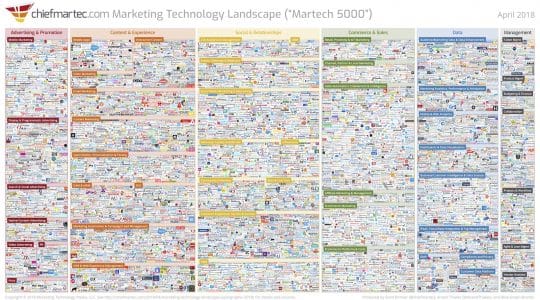
I ran into a little problem when I stepped into the world of mobile marketing: there was a whole lot of new terminology to learn. Yes, it happens. But as a writer and the kind of person who really needs to know stuff, I hate the not-knowing, especially the kind that involves words.
So I got to work learning the language of the business. As I found myself searching a lot of app marketing terms to better understand the lingo, I came across a lot of stuffy, technical definitions that lacked context or failed to address why it mattered to a marketer, and that made my unicorn spirit animal feel less-than-magical.
Because I like to keep my inner unicorn happy, I thought I’d spread a little love. I gathered my notebook scribblings, consulted some helpful resources and probably over-used my phone-a-friend lifeline to write more meaningful definitions for commonly used terms, all for you.
I know there are a lot of you out there who are new to the biz, too, and still trying to get a handle on the basics. So hopefully my pain can become your gain, and you’ll find these definitions helpful.
Just one quick disclaimer: This is not intended to be a comprehensive glossary. However, I will be writing a few more articles on app marketing terms to know, so if you have other terms you’d like TUNE to help you with, drop a note in the comments and suggest a term or concept for the next installment.
10 app marketing terms to know
1. Application Programming Interface (API): An application programming interface is a set of programming instructions (commands, routines, functions, protocols, etc.) that specify how software components should interact with each other. APIs are all about communication, literally acting as the interface between different programs and facilitating the interaction.
You’ll need to understand this as a mobile marketer because most apps are ultimately a combination of user interface, tactile interaction, integration with device features, and data delivered and consumed via APIs. To break it down more simply, is how, for example, you would be able to connect geolocation to a marketing opportunity.
Google Maps is a good example of a commonly used API. Using the programming instructions provided by the API, third-party developers are able to integrate Google Maps into their own apps.
2. Attribution: This is simply the act of identifying a user action that contributed to a desired action/conversion. Not a complex concept, but an important advancement in mobile marketing.
Here’s why: it’s actually a bit tricky in mobile marketing to understand where impressions, ad clicks, app installs and in-app events are coming from without the right software. And not knowing that — a no-no for any modern marketer — means you can’t effectively evaluate campaign performance to know what’s working so you can be smarter about where to invest ad budget.
Bonus! A related term you’ll want to know: Measurement URL. This is the basic mechanism for attributing ad clicks. Publishers embed the destination URL of their ad in a measurement URL such that user-generated ad clicks get logged by a measurement platform for downstream attribution.
3. App store optimization: Just like you’d employ various search engine optimization strategies to make sure your website turns up in search results for the right audiences, there’s a whole parallel universe of optimization strategies to help an app rank higher in top charts and searches. This practice is called app store optimization, or ASO, and can include factors like your app title, keywords, reviews and all kinds of other aspects.
The bottom line: this practice helps you boost your organic traffic and secure more app downloads. Just be sure to avoid common pitfalls.
4. Cohort: In the mobile ecosystem, this is a group of app users who have completed a specific action within a defined time frame. It is not the same as a segment, because cohorts include the dimension of time. For example, a cohort could be users who installed your app in March.
Basically, cohort analysis helps you understand the behavior of users in your app so you can be a better marketer. It is a super powerful discovery analysis, because it arms you with the information needed to improve retention and engagement, and most importantly, boost monetization efforts.
5. Cost Per Install (CPI): The amount an advertiser pays when a user installs an app. A closely related term — and used interchangeably by some advertisers — is cost per download (CPD). The key differentiator between CPI and CPD is of course the actual step of installation. It is possible for someone to download an app, but never get around to installing it. In fact, 13 percent of people who download an app never open it.
As a side note, being able to determine which source is driving installs is a critical part of measuring a successful campaign, and is one of the core features of Attribution Analytics, available through the TUNE Marketing Console.
6. Daily Active Users (DAUs): A metric measuring how many unique daily users open your app. A related metric is monthly active users (MAUs), which represents the number of unique users in your app over a one-month period. You’ll likely track both DAUs and MAUs, because while DAUs tell you how many people downloaded an app, MAUs will show how many people actually used it.
You can evaluate these metrics to determine how new features impacted usage or how well ad campaigns performed. What else can you do with this info? Analyze trends to determine how active or engaged users are, so you can develop strategies for attracting them back to your app and keeping them there.
7. In-App Messages: In-app messages are nurturing messages sent to users while they are actively using your app. In-app messages should be a natural part of the app experience because they highlight new features, offers, surveys, etc. These pop-up messages allow for more customization and design compared to standard push notifications.
In-app messages can be anything from standard notifications to highly stylized full-screen takeovers. A common use is to solicit app ratings. You can announce offers, sales and events, and new features. To learn all about in-app messaging design, testing, and churn prevention strategies, download “The Complete Guide to App Marketing.” Or check out In-App Marketing.
8. Lifetime Value (LTV): is the value your user delivers over the course of their entire lifetime engagement with your app. This could be measured by traditional monetary values — such as the amount of money a user spends over the time they use your app, if the app is revenue-generating — or in the form of app activity, such as levels completed, articles read, or images taken. It’s the big-picture metric.
Consider LTV a key measure of your app’s success over time.
9. Push Notifications. Push notifications are messages delivered to a user’s home screen (or lock screen) when not in your app. They are highly effective at driving latent users back to your app.
What you really need to know about them is that the app marketing game used to be all about acquisition, but with focus for many marketers shifting to post-install engagement, push notifications are likely to be a solid part of your game plan. There are drawbacks in comparison to in-app messaging, like being less customizable, but they can drive urgency and action you’re after.
Just as important as using them is measuring the performance and optimizing. Typically you’ll track total views, total clicks, and click-through rate — and don’t forget to A/B test.
10. Software Development Kit (SDK): A programming package that enables programmers to develop applications for a particular platform. SDKs often include sample code, support documentation, library files, debugging tools, one or more APIs (more on these below), and other useful resources. Third-party SDKs can be installed into existing apps for analytics and marketing purposes. For example, the iPhone SDK is what enables third-party programmers to create apps that run directly on the iPhone.
SDKs are typically provided for free, as companies encourage developers to create applications for their platform. For example, the TUNE Marketing Console offers a native SDK for Android, iOS, Javascript, and Windows Phone, enabling programmers to integrate our functionality into their mobile applications on each of these platforms.
Hope you learned something about app marketing terms today. You look smarter already!
Like this article? Sign up for our blog digest emails.
Author
Becky is the Senior Content Marketing Manager at TUNE. Before TUNE, she handled content strategy and marketing communications at several tech startups in the Bay Area. Becky received her bachelor's degree in English from Wake Forest University. After a decade in San Francisco and Seattle, she has returned home to Charleston, SC, where you can find her strolling through Hampton Park with her pup and enjoying the simple things in life.




Leave a Reply
You must be logged in to post a comment.